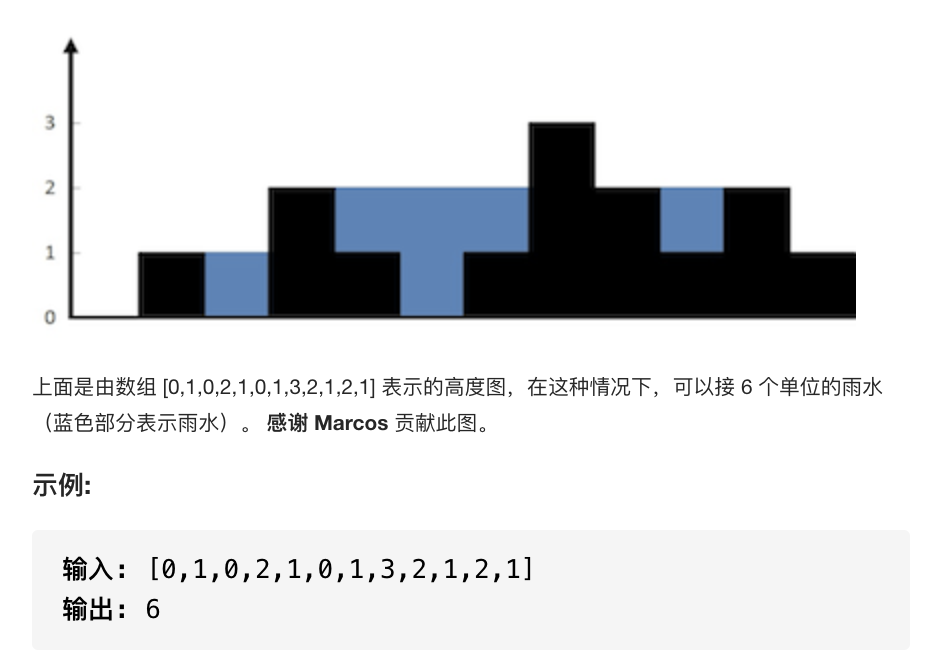题目名称
第39题:组合总和(中等)
第41题:缺失的第一个正数(困难)
第42题:接雨水(困难)
补充:个人项的题解,没有图解,没有视频。
第39题:组合总和 题目描述 给定一个无重复元素的数组candidates 和一个目标数target ,找出candidates 中所有可以使数字和为target的组合。candidates 中的数字可以无限制重复被选取。数组中所有元素都是正数,解集不能重复。
说明 1 2 3 4 5 6 输入: candidates = [2,3,6,7], target = 7, 所求解集为: [ [7], [2,2,3] ]
解题思路 这种题型,只有回溯这一种解法,涉及到回溯,所谓回溯,就是稍微有一点技巧的穷举法,穷举法一般意味着高空间利用率和时间利用率,因此只要涉及到回溯,就要考虑剪枝。其次,遇到无序数组,如果题目没有要求时间复杂度必须在O(n),一般情况下都可以去排序,而本题在排序后可以达到剪枝的效果。
完整代码 1 2 3 4 5 6 7 8 9 10 11 12 13 14 15 16 17 18 19 20 21 22 23 24 25 class Solution public List<List<Integer>> combinationSum(int [] candidates, int target) { Arrays.sort(candidates); List<List<Integer>> ans = new ArrayList<>(); dfs(candidates, target, ans, new ArrayDeque<Integer>(), 0 ); return ans; } public void dfs (int [] candidates, int target, List<List<Integer>> ans, Deque<Integer> path, int begin) if (target == 0 ){ ans.add(new ArrayList<>(path)); return ; } for (int i = begin; i < candidates.length; i++){ if (candidates[i] > target) return ; path.addLast(candidates[i]); dfs(candidates, target - candidates[i], ans, path, i); path.removeLast(); } }
第41题:缺失的第一个正数 问题描述 给你一个未排序的整数数组,请你找出其中没有出现的最小的正整数。
时间复杂度: $O(n)$
空间复杂度: $O(1)$
说明 解题思路
时间复杂度O(n):只能进行遍历的操作
空间复杂度O(1):所有操作必须是原地的
这两点带来的局限性,导致了本题必须要抓住一个关键点:一个长度为n的数组nums,其序列中如果没有缺失的正数,则$nums[i] == i$ ,也就是说,如果在这个数组的idx位置其值不是idx+1,则这个位置的数就是缺失的。因此,这道题的解题思路就确定了:使数组idx位置的值可判断,不一定非要$nums[idx] == idx + 1$,也可以使idx位置的值为负(题解 ) 。本题将$nums[idx] == idx +1$。
完整代码 1 2 3 4 5 6 7 8 9 10 11 12 13 14 15 16 17 18 19 20 21 class Solution public int firstMissingPositive (int [] nums) if (nums.length == 0 ) return 1 ; for (int i = 0 ; i < nums.length; i++){ exchange(nums, nums[i]); } for (int i = 0 ; i < nums.length; i++){ if (nums[i] != i+1 ) return i+1 ; } return nums[nums.length - 1 ] + 1 ; } public void exchange (int [] nums, int num) if (num <= 0 || num > nums.length || nums[num - 1 ] == num) return ; else { int temp = nums[num - 1 ]; nums[num - 1 ] = num; exchange(nums, temp); } }
第42题:接雨水 题目描述 给定 n 个非负整数表示每个宽度为 1 的柱子的高度图,计算按此排列的柱子,下雨之后能接多少雨水。
解题思路 这题比较难,我的第一反应特别蠢:从底向上一层层遍历,看每一层最多能接收多少雨水。这样的时间复杂度是$O(MN)$,LC直接通过不了。实际上这道题是有好的思路的,核心想法就是:确定每个idx位置上能装多少雨水。 而每个idx上装雨水的量,取决于在这个位置左右两端最高的那堵墙,因此如果我们知道每个位置上左右两端的最高位置,则可以完成计算:$res = Math.min(leftMax[idx], rightMax[idx]) - height[idx]$
完整代码 1 2 3 4 5 6 7 8 9 10 11 12 13 14 15 16 17 18 19 20 class Solution public int trap (int [] height) int len = height.length, ans = 0 ; if (len == 0 || len == 1 ) return 0 ; int [] leftMax = new int [len]; leftMax[0 ] = height[0 ]; int [] rightMax = new int [len]; rightMax[len - 1 ] = height[len - 1 ]; for (int i = 1 ; i < len; i++){ leftMax[i] = Math.max(leftMax[i - 1 ], height[i]); } for (int i = len - 2 ; i >= 0 ; i--){ rightMax[i] = Math.max(rightMax[i + 1 ], height[i]); } for (int i = 0 ; i < len; i++){ ans += Math.min(leftMax[i], rightMax[i]) - height[i]; } return ans; }
复杂度
时间复杂度:$O(n)$,只进行了遍历操作
空间复杂度:$O(n)$,保存了每个idx位置左右两端的最大值
补充 这道题其实还有更好的解法:双指针法 ,空间复杂度降到了$O(1)$,这种方法特别巧妙,利用了从左到右和从右到左两种不同的状态来计算在idx位置上可以存的雨水。但是这种方法在面试时是很难想出来的,因此这里就不赘述了。
